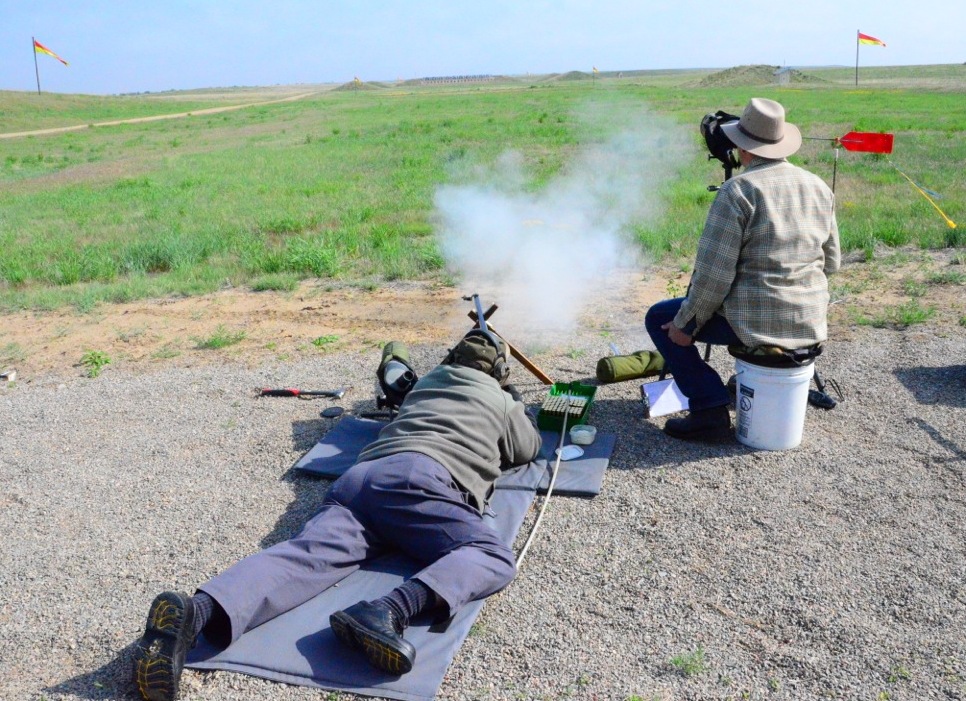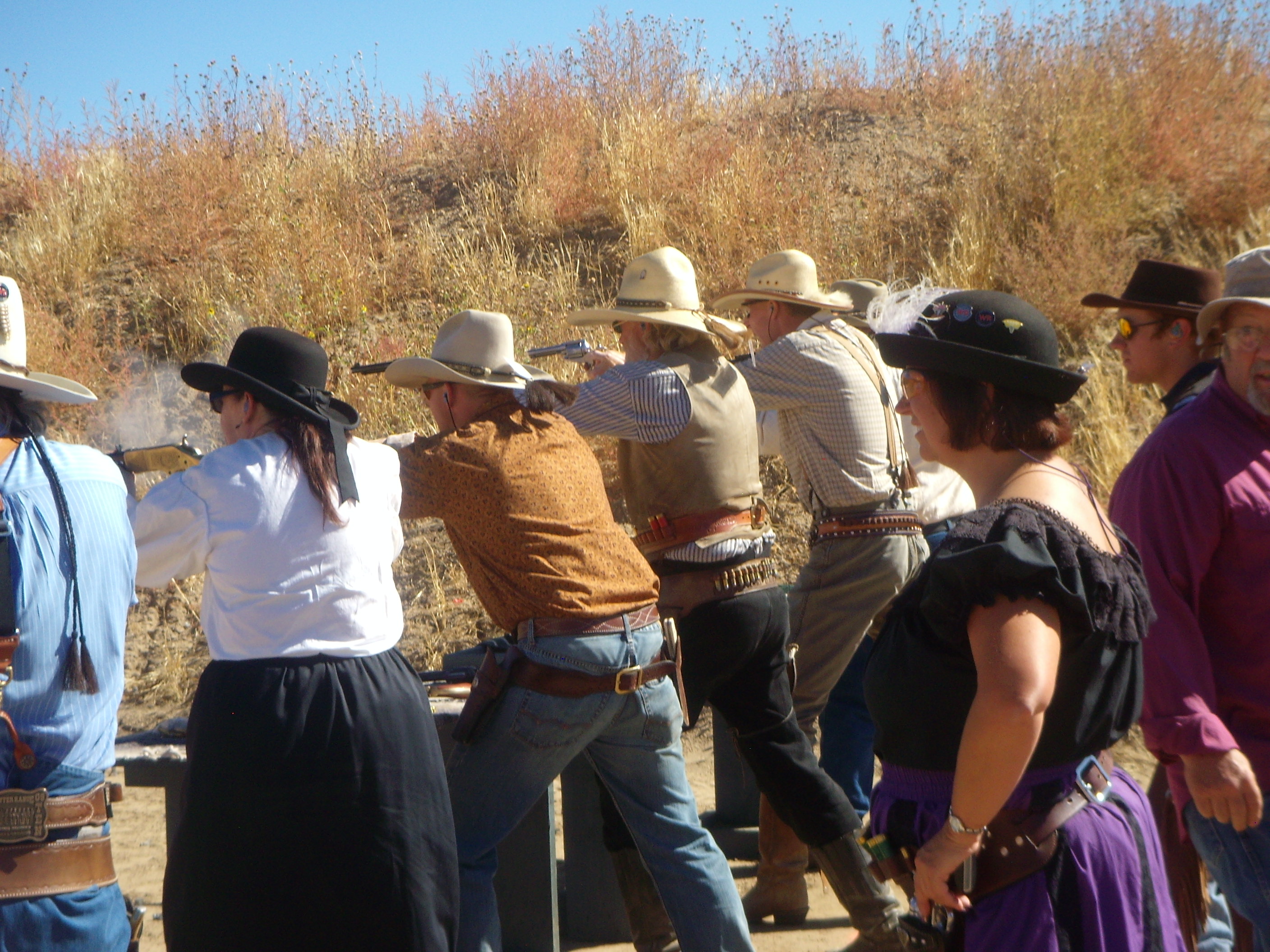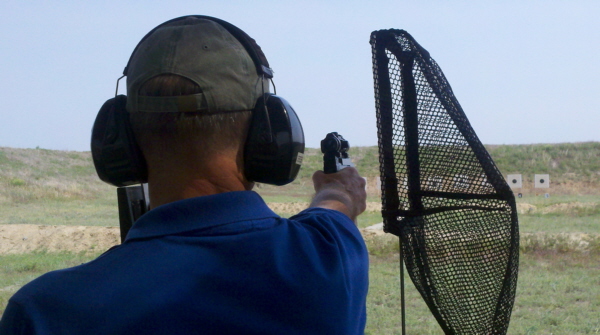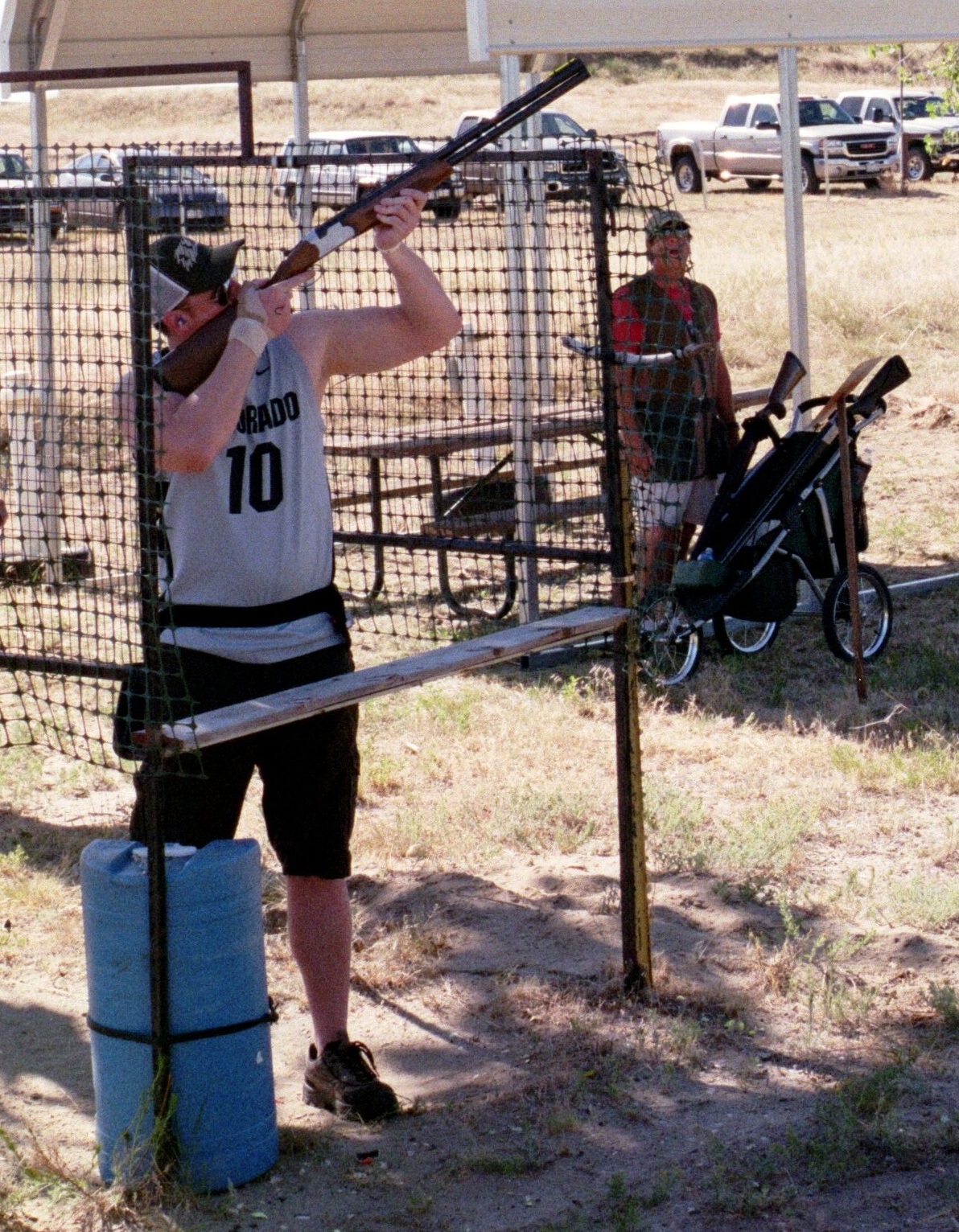Types of Shooting at CRC
Updated: November 2025
Jump to Section:
.22 PRS
A PRS .22 match is a beginner-friendly, precision rifle competition that uses .22 caliber rifles for accuracy and speed challenges at various stages, positions, and distances, typically ranging from 50 to 300+ yards. These one-day events are designed for all skill levels and involve shooting at a variety of steel targets with a limited number of rounds, usually under a timed and positional format. Competitors must be proficient with rifle handling, accuracy, and calculating for distance, often using equipment like bipods and scopes to achieve stable shooting platforms.
Back to Top
Archery
The Archery Range was damaged in a Bijou Creek flood and is currently under reconstruction.
Back to Top
Benchrest
The Benchrest community is best known as the people who shoot little groups. This is a game requiring precision and repeatability. A gun must consistently place shots into a small area to be competitive. The shooter has to read range conditions and adjust the point of aim to compensate for variables. This is the challenge of shooting groups! Tuning your gun, learning to read the wind, and adjusting for range variables all contribute to an interesting day at a match. Simply put them all through the same hole.
.22 Rimfire Benchrest
There are four classes in the CRCI Rimfire Benchrest competition. Any rifle chambered for the .22 LR cartridge having iron sights or scope is permitted. (Refer to the Shooting Classes for specific class requirements). Competitors will shoot a two-stage match using the IBS Rimfire 50 Yard Target. The IBS target has 4 sighting bullseyes at the top and 25 bulls below for record. During the timed stage, competitors will place one shot in each of the 25 bulls and have the option to use the sight in bulls at the top for unlimited sighters during the stage.
Click here to print Practice Targets @ 8-1/2" x 11" (Print "Actual Size")
Freedom Benchrest 600 and 1000 yd
The 600 and 1000 yard benchrest matches are conducted under the Freedom Benchrest rules. The three categories are Light Gun (under 17 lbs), Heavy Gun (no weight restriction), and Tactical (magazine-fed rifles). Caliber must be under 0.409. Front and rear rests cannot be connected.
Courses of fire are four 10-minute time periods during which the shooter is to register five shots for score. An unlimited number of sighters is allowed. A different target is used for record and sighting. Scores and group sizes will be recorded using ShotMarker eTargets.
The Freedom Benchrest rules manual can be found at freedombenchrest.com
Back to Top
Black Powder Long Range

Black Powder Target Rifle is an NRA sanctioned disipline that has its roots in the formation of the NRA as a marksmanship organization. Started in the 1870's with a challenge from the World Championship Irish team, a range was built at Creeds Farm on Long Island, named Creedmoor. A long range match was shot and the flegling American team beat the Irish to start a tradition of long range competitive shooting in the US.Our modern day matches at CRC are shot with single-shot rifles, originals and replicas, from the appoximate period of the Civil War to about 1900, with some exceptions for a few modern designs. These are cartridgefiring guns, generally 45 caliber, using black powder and cast lead bullets. Sharps 1874's, Winchester 1885 Hiwalls, Remington Rolling Blocks, and several others are the typical rifles used. Our Long Range course of fire is unlimited sighters and 15 shots for score at 800, 900, and 1000 yards using the standard LR target with a 35 minute time period. We have an Regional Match that also shoots a Mid-Range course at 300, 500, and 600 yards on the respective targets. Shooting is from prone using crossed sticks for rifle support. Both iron sights and replica long tube scopes are used.
Back to Top
Cowboy Action

Cowboy Action Shooting is a multifaceted amateur shooting sport in which contestants compete with firearms typical of those used in the taming of the Old West: single action revolvers; lever action rifles; and side by side double barreled, pre-1899 pump, or lever action shotguns. The shooting competition is staged in a unique, characterized, Old West style. Contestants shoot in several one-to-four gun stages (courses of fire) in which they engage steel and/or cardboard targets. Scoring is based on accuracy and speed. The truly unique aspect of Cowboy Action Shooting is the requirement placed on authentic period or western screen dress. Each participant is required to adopt a shooting alias appropriate to a character or profession of the late 19th century, or a Hollywood western star, and develop a costume accordingly. For more information, click here.
Back to Top
High Power
Highpower rifle is a large group of different competitions using center fire rifles. Each type of highpower competitions is fired at ranges of 200 to 1000 yards with restrictions on the type of rifle used. Ammunition is limited to a maximum of .35 caliber. Firing is done in a variety of positions (Prone, Sitting, Kneeling, and Standing). For complete rules governing each type of shooting, refer to the appropriate NRA or CMP rulebook.
80 Shot Course
Match consists of 20 shots slow fire standing at 200 yds; 20 shots rapid fire sitting at 200 yds; 20 shots rapid fire prone at 300 yards, and 20 shots slow fire prone at 600 yds. Service Rifles or Match Rifles as defined by the NRA are used. Two sighting shots at each distance.
100 Shot Course
Match consists of 20 shots slow fire standing at 200 yds; 20 shots rapid fire sitting at 200 yds; 20 shots rapid fire prone at 300 yards, and 40 shots slow fire prone at 600 yds. Service Rifles or Match Rifles as defined by the NRA are used. Two sighting shots at each position.
Palma Course
Match consists of 15 shots prone slow fire at 800, 900, and 1000 Yds each. Rifles are limited to .308 or .223. Two sighting shots at each position.
Fullbore Course
Match consists of firing at 300, 500, 600, 800, 900 and 1000 yds all in the prone position with rifles meeting Palma requirements. Sighting sights are convertible (can be used as record shots)
F Class
F Class follows other Mid-range Prone and Long Range courses of fire. Two categories of rifles are used. Open rifles are unlimited in caliber up to .35 and are fired off a front rest and rear bag. F-T/R limits rifle caliber to .308 Win and .223 Rem and a bipod and rear bag is used. Targets are reduced one scoring ring in size from the standard High Power targets.
600 Yard Any Any
three matches of 20 shots for record with unlimited sighters in a time limit of 25 minutes. Any rifle, Any Sights.
John C. Garand
The John C. Garand Match is held in honor of John C. Garand, the inventor of the U.S.Rifle Cal 30 M1 military rifle. Only “as-issued” U. S. Rifle cal .30 M1 (called “the Garand”), M1903A1 or M1903A3 (sometimes called “the Springfield”), U. S. Rifle cal..30 M1917 (sometimes called “the Enfield”), U. S. Rifle cal..30 M1941 (called “the Johnson”), the U. S. Krag rifle (cal..30-40) and the U. S. Carbine caliber .30 carbine M1.may be used in the competition. Competition is governed by the rules and regulations of the Civilian Marksmanship Program (CMP). Matches consist of 5 sighter shots, followed by 10 shots slow-fire prone, 10 shots rapid-fire prone, and 10 shots slow-fire standing, all at 100 yards, with ammo furnished by the CMP. Competition is held on the Schuetzen range. Competition in one of these John C. Garand match meets the CMP requirement for proof of marksmanship participation for purchasing rifles from the CMP.
Vintage Sniper Team Match
The Vintage Sniper Rifle Team Match is a two-person team event fired at 300 and 600 yards. Each team consists of two members. Any two competitors may form a Vintage Sniper Rifle Team. Each team member will fire 20 rounds from a sandbagged prone position. One team member serves as the shooter while the other serves as the spotter.The spotter may be prone, seated or standing behind or alongside the competitor. The spotter may call wind and coach the competitor. Team members must change roles after 10 shots. A total of 40 shots will be fired by each team. The Rifles must be military sniper rifles or replicas thereof issued prior to 1953. Examples are, M1903A4, 1941A1 Springfield, Garand M1C, M1D, Lee-Enfield No4T and Gewehr 98’s. Scope power is limited to 8 power.
Marine Corp League
The Marine Corps League was Chartered by the United States Congress in 1937. It is an organization made up of United States Marines and Navy Fleet Marine Force Corpsman who have been Honorably discharged from active duty service. We open our marksmanship competitions to all Marines and Navy FMF Corpsman. The Windsor Marine Corps League Detachment engages in National Competitions within the Marine Corps League. All weapons used in both the Rifle & Pistol matches must be of U.S. Military origin and have the original hard iron sights. Handicaps are allowed to enable all participants the opportunity to shoot. The Rifle Match is composed of four positions; standing, kneeling, sitting and prone. 10 rounds of ammo in each position with 3 spotter rounds firing at targets at 100 yards. The Pistol Match is composed of 30 rounds of ammo in both slow and rapid fire sets, firing at targets at 25 yards.
Back to Top
Long Range Rimfire
This rifle match is designed to be fast-paced, fun, safe, and to challenge competitor's practical and long-range shooting skills, such as wind reading, rapid target acquisition, magazine and DOPE changes during shot strings. There are five arrays of steel targets at 84, 164, 218, 328, and 421 yards. Target sizes are 2-5 MOA. An optional challenge after the match may include a target at 546 yards. Competitors may shoot prone, from a bench, or from a tripod. This is not a NRL/PRS style match. .22 Long Rifle only.
Back to Top
Mid Range Precision Rifle
MID-Range Precision Rifle Match, formerly known as the Long Range Precision Rifle Match.
The name change is to better describe the distances and caliber sizes used during the match. This is NOT a PRS match. We do NOT shoot off barricades or move positions during the match. New shooters are WELCOME and highly encouraged to attend. This is a great event to get your feet wet in a new discipline. Targets are reactive poppers varying in size between from 4.75 in wide to 6 in wide @ 300, 385, 500 and 700 meters. Please bring 50 rounds for the match itself, plus sighters. We do allow a short practice session before the match. NO PRC cartridges or short/long action Magnum cartridges. Cartridges are limited to maximum 180 grain bullet weight and under 3000 FPS.
Rifles shall weigh less than 22 pounds when fully loaded. Rifles must be on a bi-pod, bag or tripod, and rifles may be supported by a rear bag. Benches are available for use. Please bring 50 rounds for the match itself, plus sighters. Please arrive at 7:45am to help set up and ensure everyone has time for some practice. Muzzlebreaks and suppressors are absolutely permitted. This is a really fun match. For young or senior shooters exceptions may apply to the rules.
Contact the Match Director for more information.
Back to Top
NRA Pistol

A bullseye match requires you to shoot identical 90-shot courses of fire with three different calibers or types of pistols: .22, centerfire and .45 the .22 and .45 matches must be fired with pistols of those calibers while the centerfire match may be fired with any pistol .32 or larger. Most competitors use a .45 for the centerfire match. Pistols may be equipped with conventional open sights or low magnification scopes. Shooting is accomplished from the standing position with one hand. A typical match for each gun consists of a Slow Fire Match (20 rounds at 50 yards), National Match Course (10 shots slow fire at 50 yds, 10 shots timed fire at 25 yds, 10 shots rapid fire at 25 yds.), Timed Fire Match (20 shots timed fire at 25 yards) and Rapid Fire Match (20 shots rapid fire at 25 yds
Back to Top
Practical Shooting
Practical shooting is a sport in which competitors are required to combine accuracy, speed and power to successfully complete many different types of shooting "problems". At any given match a shooter may be required to shoot targets 2 meters away in one event, and 50 meters away in the next. Sometimes the targets are paper, sometimes they are steel. Often "no-shoot" penalty targets are placed near "shoot" targets. Realistic props are used to simulate a scenario that the shooter must complete. Shooting may be done from freestyle, strong hand, weak hand, prone, or any other imaginable position, depending on the course of fire. Since scoring uses both total points and elapsed time, the shooters strive to find the best combination of accuracy, speed, and power to win.
USPSA Pistol
Competitors use centerfire handguns in large calibers (9mm/.38 special is the minimum allowed) and shoot full-power loads. These handguns are carried in belt holsters and are accompanied by spare magazines or speedloaders in pouches also attached to the belt.
IDPA Pistol
International Defensive Pistol Association (IDPA) is a shooting sport based on defensive pistol techniques, using equipment including full-charge service ammunition to solve simulated "real world" self-defense scenarios. Shooters competing in defensive pistol events are required to use practical handguns and holsters that are deemed suitable for self-defense and every day use.
Steel Challenge
Steel Challenge is an action pistol event where the competitor shoots 8 different stages of fire from a designated shooting box on the ground. The box is made of raised PVC pipe and defines where the shooter must stand during the engagement of the steel targets. Each stage is comprised of 5 steel targets. These steel targets will be a combination of 10" & 12" circles and 18" by 24" rectangles. At each pass the shooter engages the 5 pieces of steel and time to complete is recorded. One pass is called a 'run' and each stage is comprised of 5 separate ' runs'. The total times for all 8 stages are calculated together for their 'Overall' time. The person who has the lowest compilation of stage times wins - therefore, who shoots the fastest - WINS ! The unique aspect of this sport is that it may be shot with center fire pistol; it may be shot with a .22 caliber rimfire pistol (ie. Buckmasters, Rugers, SW Model 41); and it may be shot with a .22 caliber rifle or a center fire pistol-Caliber carbine rifle. At a match you may only shoot 2 of the 4 guns listed above. Both are shot for score. The focus of this sport is sight picture and trigger control. Accuracy and economy of motion are the attributes that help the participant excel.
Back to Top
Silhouette

Metallic silhouette shooting is a group of target shooting disciplines that involves shooting at metal cutouts representing game animals at varying distances.
The targets used are rams, turkeys, pigs, and chickens, which are cut to different scales and set at certain distances from the shooter depending on the specific discipline. Targets are set up in groups of 5 of each kind. Targets are engaged in order of distance: chickens, pigs, turkeys, rams. The target must be knocked down or pushed off the target stand in order to score a hit; even a shot ricocheting off the ground in front of the target will count if it takes down the correct target. Shooters are allowed to have a spotter with them, who watches where the shots land and advises the shooter on corrections to make.
High Power Rifle
High power metallic silhouette uses scoped bolt action center fire rifles to knock over life size metal animal cut outs. The animals are a chicken placed at 200 meters, a pig at 300 meters, the turkey at 385 meters and a ram target at 500 meters. The course consists of 40 animals , ten at each distance. The game is fired from the standing off hand position, no slings allowed. The object is simple, hit as many as you can in a given time slot. Common cartridges for this game are the .260 Remington, 6.5 x 55 Swede, the 7mm-08 Remington and the .308 Winchester. Magnum calibers are not allowed to avoid target damage. Other calibers used are the .270 Winchester and the .30-06 but these are too powerful to shoot up to 80 shots typically fired at a match. The recoil factor will take its toll on scores. Two classes of rifles are used in silhouette, the standard or unlimited gun and a common hunting rifle class.
IHMSA Pistol Smallbore/Bigbore
Handgun silhouette matches are sanctioned by the International Handgun Metallic Silhouette Association. The full size and 1/2 size centerfire targets are set at 50, 100, 150, and 200 meters. Smallbore targets are set at 25, 50, 75 and 100 yards. A match consists of 10 shots at each distance for a total of 40 shots. Common handguns used are revolvers in .357, .41 and 44 caliber. Single shot handguns are mostly TC's and Remington XP100's in 6mm, 6.5BR, 7TCU, 7BR and 30-30's. Smallbore handguns are any .22 long rifle in revolver, single shot or semi auto configuration. Scopes and spotters are allowed in both centerfire and smallbore.
Lever Action
Cowboy Lever Action Silhouette matches consist of 40 shots – (2) 5 shot strings at each animal. Competition is split into three categories:
Cowboy Lever Action Silhouette Rifle: Any lever action center fire rifle .25 caliber or larger with a tubular magazine of original manufacture or replica thereof. A rimmed case loaded with a round or flat nosed bullet must be used. Exception: 35 Remington is allowed. Targets: Long Range Pistol, at distances of 50-100-150-200 meters.
Pistol Cartridge Cowboy Lever Action Silhouette Rifle: Any lever action rifle with a tubular magazine. A rimmed pistol cartridge loaded with a round or flat nosed bullet must be used i.e. 25-20, 32-20, 38’s, .357 Magnum, 38-40, 44’s, 44-40, .45 Colt, .45 Long Colt, .22 Magnum and .22 Long Rifle. Targets: Hunter’s Pistol Targets, at distances of 40-60-77-100 meters.
Smallbore Cowboy Rifle Silhouette Rifle: Any lever action, pump, or semi-auto rimfire rifle with a tubular magazine. .22 long rifle ammunition only. Hyper velocity ammunition prohibited. Targets: Smallbore Hunter’s Pistol Targets, at distances of 40-60-77-100 meters.
Smallbore
Ten targets are fired upon from each of four ranges. 10 Chickens at 40 meters, 10 Pigs at 60 meters, 10 Turkeys at 77 meters, and 10 Rams at 100 meters. All shooting will be performed offhand with no support. Standard (Heavy rifles) may not exceed 10 lbs. 2 oz. Hunting (Light) rifles may not exceed 8 ½ lbs or have a trigger pull of less than 2 lbs. Heavy jackets, palm rests, slings, etc. may not be used for support. Only 22 LR standard and high velocity ammunition may be used. Stingers and other hyper-velocity ammo are not permitted.
Back to Top
Smallbore Prone

Smallbore two day matches are NRA sanctioned matches using single shot .22 caliber target rifles, following NRA rules and regulations, and firing at ranges of 50 and 100 yards from the prone position. A typical match consists of 20 record shots on each of 16 targets over the two days. The smallbore summer league is a much more relaxed series of one day matches for the purpose of introducing smallbore shooting to new shooters while providing practice for the more serious smallbore shooter.
Back to Top
Sporting Clays

Sporting Clays Events are non-competitive shoots. A course consists of 10 stations. 10 targets are shot at each station for a total outing of 100 targets per person. Targets are thrown as singles and pairs. A pair of targets may be thrown at the same time, as a following pair (thrown sequentially), or on report (the second clay launched on the report of the shooter’s gun). Each station is unique. Throughout a course, the shooters might see targets crossing from either side, coming inward, going outward, flying straight up, rolling on the ground, or arcing high in the air. The configuration of the stations is often changed to maintain interest for the shooters and for environmental preservation of the course. Shooters must provide their own shotgunsa and ammunition.
Back to Top
Steel Dogs 22LR Rimfire Competition
(Revised: April 2022)
The .22LR Steel Dogs match is a rifle only event in which we shoot 2”x 6” steel prairie dog silhouettes from 35-150 yards and additional steel targets from 165-200 yards. This was started several years ago as a way to practice reading wind conditions and its effect on projectiles with a less expensive round.
We shoot a total of 50-70 rounds for the entire match as follows. Spirit of the match is in prone with either a bipod/ bags, or if you are adventurous, a sling. No rests or tripods allowed. We also allow shooting off the bench with a bipod or bags as some of our members cannot physically get into prone anymore. Any .22LR rifle that is safe is allowed, but a box magazine rifle is preferred by most shooters for fast magazine changes. Please bring an empty chamber indicator flag if you have one.
Match Director is usually there between 7:30-7:45 AM on the Schuetzen range. Set up at 8 AM. Mandatory safety brief at 8:15 and warm ups from 8:20-8:50. Match starts at 9, typically ends around noon depending how many competitors show up. Cost is $10 per person, non members must sign liability waiver found here (only needs to be done once per year online).
- String 1 10 shots: Shoot ‘em up
3 minutes to shoot 10 targets, 1 round per target from ascending ranges of 35-150 yards
- String 2 10 shots: Shoot ‘em down
3 minutes to shoot 10 targets, 1 round per target from descending ranges of 150-35 yards
- String 3 10-30 shots: Three chances at glory
3 minutes to shoot 10 targets, up to 3 attempts per target (if first or second shot misses), but decreasing point value if more than one shot taken per target (1/2 and ¼ point values for hits 2 and 3). Start at target #1 at 35 yd and progress upwards to target #10 at 150 yd
- String #4 10 shots: Mad Minute
1 minute to shoot 1 round per target at targets #1-#10. Can start with target #1 and ascend or start at target #10 and descend, must state which option you will use prior to start. Must shoot targets in sequence.
- String #5 10 shots: Decision Time
3 minutes to shoot at 4 targets. One 6” diamond at 165 yd, one 6” diamond at 180 yd, one 6” diamond at 200 yd, and a 1.5 MOA swinger at 200 yd hiding behind a 10” steel gong with a 3” hole in the center. LED hit indicator must illuminate for score to count on the 1.5MOA target. Your choice to hit targets in any sequence you desire, but only 10 rounds of ammo. (most shooters will start with the 200yd 6” steel diamond so they can see dirt splash in the berm if they miss)
Back to Top